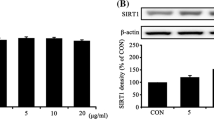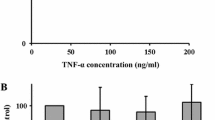Abstract
Exposure to oxidants results in cellular alterations that are implicated in aging and age-associated diseases. Here, we report that brief, low-level oxidative exposure leads to long-term elevation of cellular reactive oxygen species (ROS) levels and oxidative damage in human skin fibroblasts. Elevated ROS impairs the transforming growth factor-β (TGF-β) pathway, through reduction of type II TGF-β receptor (TβRII) and SMAD3 protein levels. This impairment results in reduced expression of connective tissue growth factor (CTGF/CCN2) and type I collagen, which are regulated by TGF-β. Restoration of TβRII and SMAD3 together, but not separately, reinstates TGF-β signaling and increases CTGF/CCN2 and type I collagen levels. Treatment with the anti-oxidant N-acetylcysteine reduces ROS elevation and normalizes TGF-β signaling and target gene expression. These data reveal a novel linkage between limited oxidant exposure and altered cellular redox homeostasis that results in impairment of TGF-β signaling. This linkage provides new insights regarding the mechanism by which aberrant redox homeostasis is coupled to decline of collagen production, a hallmark of human skin aging.








Similar content being viewed by others
References
Bedard K, Krause KH (2007) The NOX family of ROS-generating NADPH oxidases: physiology and pathophysiology. Physiol Rev 87(1):245–313. doi:10.1152/physrev.00044.2005
Bonni S, Wang HR, Causing CG, Kavsak P, Stroschein SL, Luo K, Wrana JL (2001) TGF-beta induces assembly of a Smad2-Smurf2 ubiquitin ligase complex that targets SnoN for degradation. Nat Cell Biol 3(6):587–595. doi:10.1038/35078562
Bossis G, Melchior F (2006) Regulation of SUMOylation by reversible oxidation of SUMO conjugating enzymes. Mol Cell 21(3):349–357. doi:10.1016/j.molcel.2005.12.019
Boyd FT, Massague J (1989) Transforming growth factor-beta inhibition of epithelial cell proliferation linked to the expression of a 53-kDa membrane receptor. J Biol Chem 264(4):2272–2278
Brigstock DR (1999) The connective tissue growth factor/cysteine-rich 61/nephroblastoma overexpressed (CCN) family. Endocr Rev 20(2):189–206
Cadenas E, Davies KJ (2000) Mitochondrial free radical generation, oxidative stress, and aging. Free Radic Biol Med 29(3–4):222–230
Davies KJ (1987) Protein damage and degradation by oxygen radicals. I. General aspects. J Biol Chem 262(20):9895–9901
Davies KJ, Delsignore ME (1987) Protein damage and degradation by oxygen radicals. III. Modification of secondary and tertiary structure. J Biol Chem 262(20):9908–9913
Davies KJ, Goldberg AL (1987a) Oxygen radicals stimulate intracellular proteolysis and lipid peroxidation by independent mechanisms in erythrocytes. J Biol Chem 262(17):8220–8226
Davies KJ, Goldberg AL (1987b) Proteins damaged by oxygen radicals are rapidly degraded in extracts of red blood cells. J Biol Chem 262(17):8227–8234
Davies KJ, Delsignore ME, Lin SW (1987a) Protein damage and degradation by oxygen radicals. II. Modification of amino acids. J Biol Chem 262(20):9902–9907
Davies KJ, Lin SW, Pacifici RE (1987b) Protein damage and degradation by oxygen radicals. IV. Degradation of denatured protein. J Biol Chem 262(20):9914–9920
Droge W (2002) Free radicals in the physiological control of cell function. Physiol Rev 82(1):47–95. doi:10.1152/physrev.00018.2001
Duncan MR, Frazier KS, Abramson S, Williams S, Klapper H, Huang X, Grotendorst GR (1999) Connective tissue growth factor mediates transforming growth factor beta-induced collagen synthesis: down-regulation by cAMP. FASEB J 13(13):1774–1786
Favilli F, Iantomasi T, Marraccini P, Stio M, Lunghi B, Treves C, Vincenzini MT (1994) Relationship between age and GSH metabolism in synaptosomes of rat cerebral cortex. Neurobiol Aging 15(4):429–433
Fisher GJ, Kang S, Varani J, Bata-Csorgo Z, Wan Y, Datta S, Voorhees JJ (2002) Mechanisms of photoaging and chronological skin aging. Arch Dermatol 138(11):1462–1470
Fisher GJ, Quan T, Purohit T, Shao Y, Cho MK, He T, Varani J, Kang S, Voorhees JJ (2009) Collagen fragmentation promotes oxidative stress and elevates matrix metalloproteinase-1 in fibroblasts in aged human skin. Am J Pathol 174(1):101–114. doi:10.2353/ajpath.2009.080599
Fukuchi M, Imamura T, Chiba T, Ebisawa T, Kawabata M, Tanaka K, Miyazono K (2001) Ligand-dependent degradation of Smad3 by a ubiquitin ligase complex of ROC1 and associated proteins. Mol Biol Cell 12(5):1431–1443
Herrling T, Jung K, Fuchs J (2006) Measurements of UV-generated free radicals/reactive oxygen species (ROS) in skin. Spectrochim Acta A Mol Biomol Spectrosc 63(4):840–845. doi:10.1016/j.saa.2005.10.013
Hertig IA, Hassoun PM, Zulueta JJ, Thannickal VJ, Fanburg BL (1993) Mechanism of basal and transforming growth factor beta 1 stimulated H2O2 release by endothelial cells. Trans Assoc Am Phys 106:179–186
Ihn H, LeRoy EC, Trojanowska M (1997) Oncostatin M stimulates transcription of the human alpha2(I) collagen gene via the Sp1/Sp3-binding site. J Biol Chem 272(39):24666–24672
Izzi L, Attisano L (2004) Regulation of the TGFbeta signalling pathway by ubiquitin-mediated degradation. Oncogene 23(11):2071–2078. doi:10.1038/sj.onc.1207412
Jiang Z, Seo JY, Ha H, Lee EA, Kim YS, Han DC, Uh ST, Park CS, Lee HB (2003) Reactive oxygen species mediate TGF-beta1-induced plasminogen activator inhibitor-1 upregulation in mesangial cells. Biochem Biophys Res Commun 309(4):961–966
Jiang F, Zhang Y, Dusting GJ (2011) NADPH oxidase-mediated redox signaling: roles in cellular stress response, stress tolerance, and tissue repair. Pharmacol Rev 63(1):218–242. doi:10.1124/pr.110.002980
Kavsak P, Rasmussen RK, Causing CG, Bonni S, Zhu H, Thomsen GH, Wrana JL (2000) Smad7 binds to Smurf2 to form an E3 ubiquitin ligase that targets the TGF beta receptor for degradation. Mol Cell 6(6):1365–1375
Kim YK, Bae GU, Kang JK, Park JW, Lee EK, Lee HY, Choi WS, Lee HW, Han JW (2006) Cooperation of H2O2-mediated ERK activation with Smad pathway in TGF-beta1 induction of p21WAF1/Cip1. Cell Signal 18(2):236–243. doi:10.1016/j.cellsig.2005.04.008
Laiho M, Weis MB, Massague J (1990) Concomitant loss of transforming growth factor (TGF)-beta receptor types I and II in TGF-beta-resistant cell mutants implicates both receptor types in signal transduction. J Biol Chem 265(30):18518–18524
Lin X, Liang M, Feng XH (2000) Smurf2 is a ubiquitin E3 ligase mediating proteasome-dependent degradation of Smad2 in transforming growth factor-beta signaling. J Biol Chem 275(47):36818–36822. doi:10.1074/jbc.C000580200
Lin X, Liang M, Liang YY, Brunicardi FC, Feng XH (2003a) SUMO-1/Ubc9 promotes nuclear accumulation and metabolic stability of tumor suppressor Smad4. J Biol Chem 278(33):31043–31048. doi:10.1074/jbc.C300112200
Lin X, Liang M, Liang YY, Brunicardi FC, Melchior F, Feng XH (2003b) Activation of transforming growth factor-beta signaling by SUMO-1 modification of tumor suppressor Smad4/DPC4. J Biol Chem 278(21):18714–18719. doi:10.1074/jbc.M302243200
Liu L, Gu L, Ma Q, Zhu D, Huang X (2013) Resveratrol attenuates hydrogen peroxide-induced apoptosis in human umbilical vein endothelial cells. Eur Rev Med Pharmacol Sci 17(1):88–94
Long H, Shi T, Borm PJ, Maatta J, Husgafvel-Pursiainen K, Savolainen K, Krombach F (2004) ROS-mediated TNF-alpha and MIP-2 gene expression in alveolar macrophages exposed to pine dust. Part Fibre Toxicol 1(1):3. doi:10.1186/1743-8977-1-3
Manza LL, Codreanu SG, Stamer SL, Smith DL, Wells KS, Roberts RL, Liebler DC (2004) Global shifts in protein sumoylation in response to electrophile and oxidative stress. Chem Res Toxicol 17(12):1706–1715. doi:10.1021/tx049767l
Meares GP, Fontanilla D, Broniowska KA, Andreone T, Lancaster JR Jr, Corbett JA (2013) Differential responses of pancreatic beta-cells to ROS and RNS. Am J Physiol Endocrinol Metab 304(6):E614–E622. doi:10.1152/ajpendo.00424.2012
Moustakas A, Souchelnytskyi S, Heldin CH (2001) Smad regulation in TGF-beta signal transduction. J Cell Sci 114(Pt 24):4359–4369
Mukherjee TK, Mishra AK, Mukhopadhyay S, Hoidal JR (2007) High concentration of antioxidants N-acetylcysteine and mitoquinone-Q induces intercellular adhesion molecule 1 and oxidative stress by increasing intracellular glutathione. J Immunol 178(3):1835–1844
Ohba M, Shibanuma M, Kuroki T, Nose K (1994) Production of hydrogen peroxide by transforming growth factor-beta 1 and its involvement in induction of egr-1 in mouse osteoblastic cells. J Cell Biol 126(4):1079–1088
Quan T, Fisher GJ (1999) Cloning and characterization of the human protein kinase C-eta promoter. J Biol Chem 274(40):28566–28574
Quan T, He T, Voorhees JJ, Fisher GJ (2001) Ultraviolet irradiation blocks cellular responses to transforming growth factor-beta by down-regulating its type-II receptor and inducing Smad7. J Biol Chem 276(28):26349–26356. doi:10.1074/jbc.M010835200
Quan T, He T, Kang S, Voorhees JJ, Fisher GJ (2002) Connective tissue growth factor: expression in human skin in vivo and inhibition by ultraviolet irradiation. J Invest Dermatol 118(3):402–408. doi:10.1046/j.0022-202x.2001.01678.x
Quan T, He T, Kang S, Voorhees JJ, Fisher GJ (2004) Solar ultraviolet irradiation reduces collagen in photoaged human skin by blocking transforming growth factor-beta type II receptor/Smad signaling. Am J Pathol 165(3):741–751
Quan T, Shao Y, He T, Voorhees JJ, Fisher GJ (2010) Reduced expression of connective tissue growth factor (CTGF/CCN2) mediates collagen loss in chronologically aged human skin. J Invest Dermatol 130(2):415–424. doi:10.1038/jid.2009.224
Rhyu DY, Yang Y, Ha H, Lee GT, Song JS, Uh ST, Lee HB (2005) Role of reactive oxygen species in TGF-beta1-induced mitogen-activated protein kinase activation and epithelial-mesenchymal transition in renal tubular epithelial cells. J Am Soc Nephrol 16(3):667–675. doi:10.1681/ASN.2004050425
Saitoh H, Hinchey J (2000) Functional heterogeneity of small ubiquitin-related protein modifiers SUMO-1 versus SUMO-2/3. J Biol Chem 275(9):6252–6258
Sohal RS, Arnold L, Orr WC (1990) Effect of age on superoxide dismutase, catalase, glutathione reductase, inorganic peroxides, TBA-reactive material, GSH/GSSG, NADPH/NADP+ and NADH/NAD+ in Drosophila melanogaster. Mech Ageing Dev 56(3):223–235
Teramoto S, Fukuchi Y, Uejima Y, Ito H, Orimo H (1992) Age-related changes in GSH content of eyes in mice—a comparison of senescence-accelerated mouse (SAM) and C57BL/J mice. Comp Biochem Physiol Comp Physiol 102(4):693–696
Thannickal VJ, Fanburg BL (1995) Activation of an H2O2-generating NADH oxidase in human lung fibroblasts by transforming growth factor beta 1. J Biol Chem 270(51):30334–30338
Thannickal VJ, Hassoun PM, White AC, Fanburg BL (1993) Enhanced rate of H2O2 release from bovine pulmonary artery endothelial cells induced by TGF-beta 1. Am J Physiol 265(6 Pt 1):L622–L626
Wu WS (2006) The signaling mechanism of ROS in tumor progression. Cancer Metastasis Rev 25(4):695–705. doi:10.1007/s10555-006-9037-8
Zawel L, Dai JL, Buckhaults P, Zhou S, Kinzler KW, Vogelstein B, Kern SE (1998) Human Smad3 and Smad4 are sequence-specific transcription activators. Mol Cell 1(4):611–617
Zhou W, Ryan JJ, Zhou H (2004) Global analyses of sumoylated proteins in Saccharomyces cerevisiae. Induction of protein sumoylation by cellular stresses. J Biol Chem 279(31):32262–32268. doi:10.1074/jbc.M404173200
Acknowledgments
We would like to thank Diane Fiolek for graphic material and administrative assistance; Dr. Maria Trojanowski (Boston University) for providing pCOL1α2-CAT; and Dr. Bert Vogelstein (Johns Hopkins) for providing 4X SBE-LUX. This work was supported, in part, by the National Institutes of Health, AG019364 (GF) and AG031452 (GF).
Author information
Authors and Affiliations
Corresponding author
Electronic supplementary material
Below is the link to the electronic supplementary material.
ESM 1
(JPEG 1978 kb)
About this article
Cite this article
He, T., Quan, T., Shao, Y. et al. Oxidative exposure impairs TGF-β pathway via reduction of type II receptor and SMAD3 in human skin fibroblasts. AGE 36, 9623 (2014). https://doi.org/10.1007/s11357-014-9623-6
Received:
Accepted:
Published:
DOI: https://doi.org/10.1007/s11357-014-9623-6





